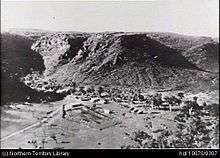Areyonga, Northern Territory
| Areyonga Northern Territory | |
|---|---|
 Areyonga | |
| Coordinates | 24°04′23″S 132°16′09″E / 24.07306°S 132.26917°ECoordinates: 24°04′23″S 132°16′09″E / 24.07306°S 132.26917°E |
| Population | 235 (2011 census)[1] |
| Established | 1920s |
| Postcode(s) | 0872 |
| Location | 220 km (137 mi) west of Alice Springs |
| LGA(s) | MacDonnell Shire |
| Territory electorate(s) | MacDonnell |
| Federal Division(s) | Lingiari |
Areyonga (also called Utju in Pitjantjatjara) is a small town in the Northern Territory of Australia. It is located about 220 km west of Alice Springs. It has a population of about 300, most of whom are Aboriginal. The people are mostly Pitjantjatjara, with some Arrernte and Walpiri families. The town is governed by Areyonga Aboriginal Community.
Areyonga was founded during the 1920s. A long drought forced Pitjantatjara families to leave Kaḻṯukatjara and other places in the Petermann Ranges. They originally moved to Hermannsburg and then set up a new community at Areyonga. A Lutheran mission was established in the settlement in the 1940s. In the 1970s, many people from the mission moved back to the community at Kaḻṯukatjara. The Lutheran mission at Areyonga was closed in 1990, and the land was given back to the native people as part of the Haasts Bluff Aboriginal Land Trust.[2]
Areyonga is in the valley of a deep and spectacular gorge, and has an abundant flora and fauna life along its creekbed and waterholes, including a large wild donkey population who bray day and night, adding to the town's charm. It has a thriving Community Arts Centre with sought after artists, and the town encourages visitors (no permit is required, despite notes on outdated maps). It is only a 20 km detour from the Mereenie Loop for visitors coming through from Kings Canyon.

References
- ↑ Australian Bureau of Statistics (31 October 2012). "Areyonga (SSC)". 2011 Census QuickStats. Retrieved 31 January 2014.
- ↑ Trengove, Anna (7 November 2011). "Areyonga (1920s - )". Find & Connect. Australian Government, Department of Families, Housing, Community Services and Indigenous Affairs. Retrieved 18 March 2013.
External links
- Community profile on the MacDonnell Shire website
- Areyonga School